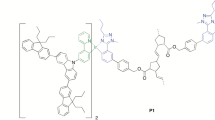Abstract
Studies of the effect of different electrode combinations on the device characteristics of simple three layer light-emitting diodes (LEDs) prepared with poly(p-phenylenevinylene) (PPV) as the emissive layer sandwiched between two metal contacts have shown that it is generally more difficult to inject electrons than holes. In order to improve the efficiency of such devices it is, therefore, necessary to develop methods to enhance the injection of electrons and we illustrate here one example where we have successfully achieved this by the introduction of a further, electron transport, layer. The result is an eight fold increase in efficiency over our best three layer PPV devices. The efficiency is also dependent on the details of the polymer electronic structure and using a family of copolymers we have been able to produce enhancements in efficiency to values of up to 30 times that of the corresponding PPV devices. Variations in the polymer electronic structure also affect the colour of emission and the same family of copolymers allow control of emission colour from blue/green to orange/red. Supramolecular control of the copolymer electronic structure can be achieved by lithographic patterning and we show that it is possible to produce regions within a single polymer film that possess different fy-⪮* energy gaps.
Similar content being viewed by others
References
J.H. Burroughes, D.D.C. Bradley, A.R. Brown, R.N. Marks, K. MacKay, R.H. Friend, P.L. Burn, and A.B. Holmes, Nature, 347, 539, (1990).
D. Braun and A. J. Heeger, Appl. Phys. Lett., 58, 1982, (1991).
C.W. Tang and S.A. Van Slyke, Appl. Phys. Lett., 51, 913, (1987)
C. Adachi, S. Tokito, T. Tsutsui, and S. Saito, Jap. J. Appl. Phys. 27, L269, (1988})
C. Adachi, T. Tsutsui, and S. Saito, Appl. Phys. Lett., 56, 799, (1990).
K.S. Wong, D.D.C. Bradley, W. Hayes, J.F. Ryan, R.H. Friend, H. Lindenberger, and S. Roth, J. Phys. C: Solid State Phys., 20, L187, (1987).
P.L. Burn, A.B. Holmes, A. Kraft, A.R. Brown, D.D.C. Bradley, and R.H. Friend, J. Chem. Soc, Chem. Commun., [ntin press.}
I.D.W. Samuel, private communication.
C.W. Spangler, private communication.
P.L. Burn, A.B. Holmes, A. Kraft, A.R. Brown, D.D.C. Bradley, and R. H. Friend, manuscript in preparation.
D.D.C. Bradley, A.R. Brown, P.L. Burn, R.H. Friend, A.B. Holmes, and A. Kraft, Springer Ser. Solid-State Sci., IWEPP, March. 1991, in press.
P.L. Burn, A.B. Holmes, A. Kraft, A.R. Brown, D.D.C. Bradley, R.H. Friend, and R.W. Gymer, manuscript submitted.
Acknowledgement
We thank R.W. Jackson for his help in preparing the polymers. We thank SERC, Christ's College (Dow Research Fellowship for PLB), Deutsche Forschungsgemeinschaft _AK), and Cambridge Research and Innovation Limited for support.
Author information
Authors and Affiliations
Rights and permissions
About this article
Cite this article
Burn, P.L., Holmes, A.B., Kraft, A. et al. Light-Emitting Diodes Based on Conjugated Polymers: Control of Colour and Efficiency. MRS Online Proceedings Library 247, 647–653 (1992). https://doi.org/10.1557/PROC-247-647
Published:
Issue Date:
DOI: https://doi.org/10.1557/PROC-247-647




